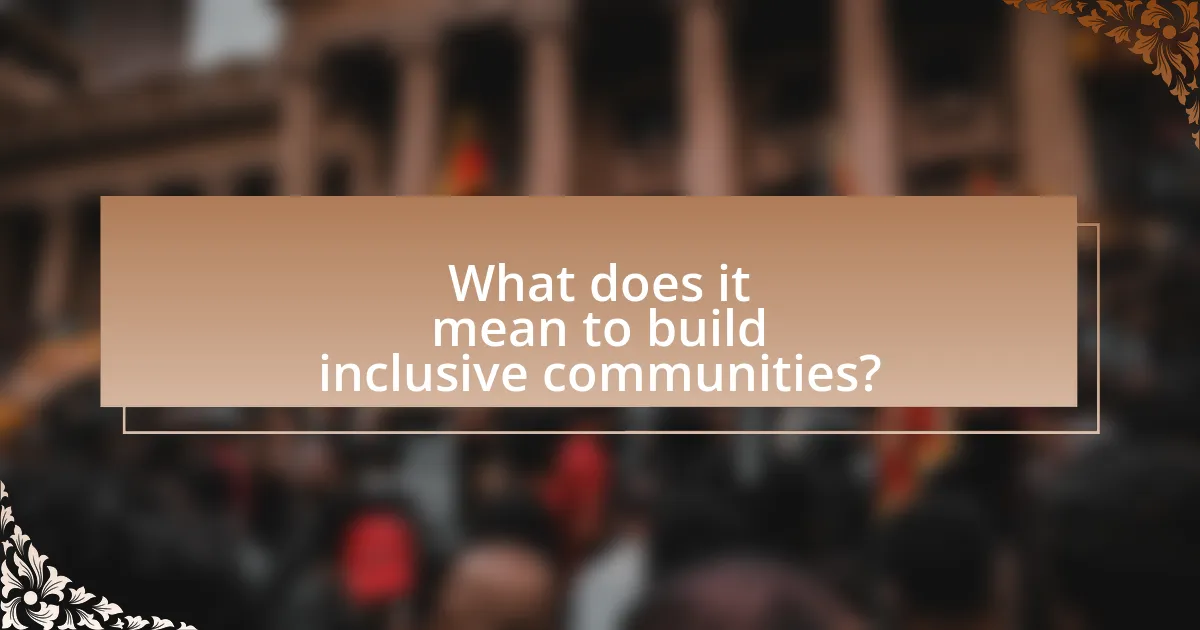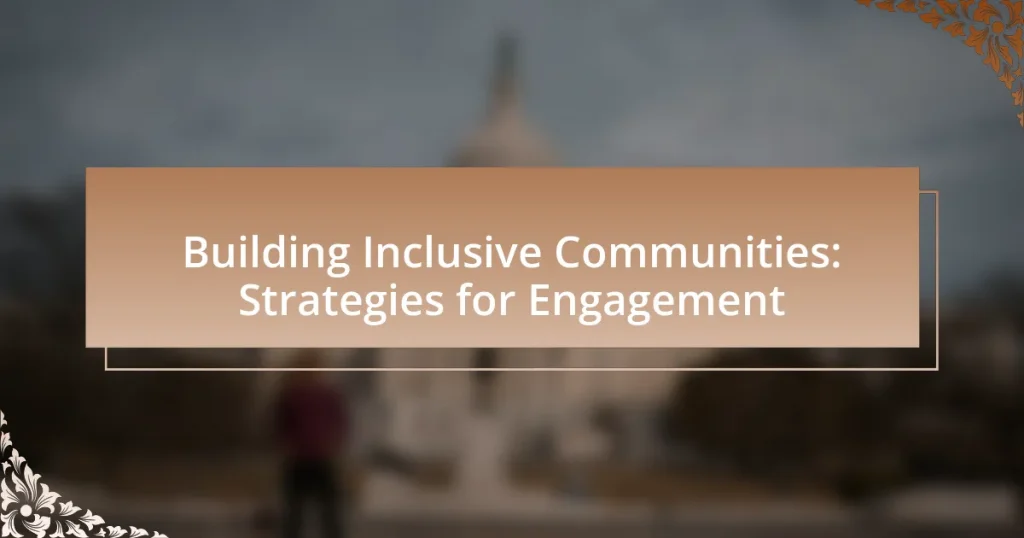Building inclusive communities involves creating environments where individuals from diverse backgrounds feel welcomed, valued, and empowered to participate. This article outlines the importance of inclusivity in community building, highlighting key principles such as accessibility, equity, diversity, and participation. It discusses the positive impacts of inclusivity on community dynamics, the challenges faced in fostering inclusive environments, and the barriers marginalized groups encounter. Additionally, the article presents effective engagement strategies, the role of communication, and methods for measuring the success of inclusivity initiatives, ultimately emphasizing best practices for sustainable engagement and long-term commitment to inclusivity.

What does it mean to build inclusive communities?
Building inclusive communities means creating environments where all individuals, regardless of their background, identity, or abilities, feel welcomed, valued, and empowered to participate fully. This involves actively removing barriers to participation, fostering a culture of respect and understanding, and ensuring equitable access to resources and opportunities. Research indicates that inclusive communities enhance social cohesion and improve overall well-being, as evidenced by studies showing that diverse groups lead to more innovative solutions and better decision-making outcomes.
Why is inclusivity important in community building?
Inclusivity is important in community building because it fosters a sense of belonging and enhances social cohesion. When diverse voices and perspectives are included, communities benefit from a wider range of ideas and solutions, leading to more effective problem-solving and innovation. Research indicates that inclusive communities experience higher levels of participation and engagement, which are critical for sustainable development. For example, a study by the National Civic League found that inclusive practices in community engagement lead to improved trust and collaboration among residents, ultimately resulting in stronger, more resilient communities.
What are the key principles of inclusivity?
The key principles of inclusivity are accessibility, equity, diversity, and participation. Accessibility ensures that all individuals can engage fully, regardless of their abilities or circumstances. Equity involves providing fair treatment and opportunities tailored to individual needs, recognizing that different people may require different resources to achieve similar outcomes. Diversity emphasizes the importance of including a wide range of perspectives, backgrounds, and experiences, which enriches community interactions and decision-making. Participation encourages active involvement from all community members, fostering a sense of belonging and ownership in communal activities. These principles are essential for creating environments where everyone feels valued and empowered to contribute.
How does inclusivity impact community dynamics?
Inclusivity positively impacts community dynamics by fostering a sense of belonging and enhancing social cohesion. When diverse groups are included, individuals feel valued and respected, which leads to increased participation in community activities. Research indicates that inclusive communities experience lower levels of conflict and higher levels of trust among members, as evidenced by a study published in the Journal of Community Psychology, which found that inclusive practices correlate with improved community well-being and engagement. This dynamic not only strengthens relationships but also encourages collaboration, innovation, and resilience within the community.
What are the challenges in building inclusive communities?
Building inclusive communities faces several challenges, including social fragmentation, economic disparities, and cultural differences. Social fragmentation occurs when communities are divided along lines of race, class, or ideology, making it difficult to foster a sense of belonging among diverse groups. Economic disparities can limit access to resources and opportunities, hindering participation from marginalized populations. Cultural differences may lead to misunderstandings or conflicts, complicating efforts to create a cohesive community. According to a report by the National Civic League, these barriers can significantly impede community engagement and collaboration, highlighting the need for targeted strategies to address them effectively.
What barriers do marginalized groups face?
Marginalized groups face systemic barriers such as discrimination, lack of access to resources, and social exclusion. Discrimination manifests in various forms, including racial, gender, and socioeconomic biases, which limit opportunities for education, employment, and healthcare. For instance, a report by the National Women’s Law Center highlights that women of color experience higher unemployment rates compared to their white counterparts, illustrating the intersection of race and gender discrimination. Additionally, marginalized communities often encounter limited access to essential services, such as affordable housing and quality education, which perpetuates cycles of poverty and inequality. Social exclusion further isolates these groups, reducing their participation in civic activities and decision-making processes, as evidenced by studies showing lower voter turnout rates among marginalized populations.
How can misconceptions about inclusivity hinder progress?
Misconceptions about inclusivity can significantly hinder progress by fostering exclusionary practices and limiting diverse participation. When individuals or organizations misunderstand inclusivity as merely tokenism or compliance with regulations, they fail to create genuine environments that welcome diverse perspectives. This lack of authentic engagement can lead to a homogenous culture that stifles innovation and creativity, as diverse viewpoints are essential for problem-solving and progress. Research indicates that organizations with diverse teams are 35% more likely to outperform their competitors, highlighting the importance of true inclusivity in driving success. Therefore, misconceptions not only impede social cohesion but also diminish the potential for collective advancement.

What strategies can be employed for effective engagement?
Effective engagement can be achieved through strategies such as active listening, inclusive communication, and collaborative decision-making. Active listening involves fully concentrating on what is being said, which fosters trust and understanding among community members. Inclusive communication ensures that all voices are heard, particularly those from marginalized groups, thereby enhancing participation. Collaborative decision-making encourages shared ownership of outcomes, leading to greater commitment and investment in community initiatives. Research indicates that communities employing these strategies experience higher levels of participation and satisfaction, as evidenced by a study published in the Journal of Community Engagement and Scholarship, which found that inclusive practices significantly improve community cohesion and effectiveness.
How can community leaders foster inclusivity?
Community leaders can foster inclusivity by actively engaging diverse groups in decision-making processes. This approach ensures that various perspectives are represented, which can be supported by research indicating that inclusive decision-making leads to better community outcomes. For instance, a study by the National League of Cities found that cities with inclusive practices saw increased civic participation and improved trust in local government. By implementing strategies such as community forums, outreach programs, and collaborative projects, leaders can create an environment where all voices are heard and valued, ultimately strengthening community bonds and enhancing social cohesion.
What role does communication play in engagement?
Communication is essential for engagement as it facilitates understanding, connection, and collaboration among individuals. Effective communication fosters an environment where diverse voices are heard, leading to increased participation and a sense of belonging within a community. Research indicates that communities with strong communication practices experience higher levels of engagement, as evidenced by a study published in the Journal of Community Psychology, which found that inclusive communication strategies significantly enhance community involvement and satisfaction.
How can leaders create safe spaces for dialogue?
Leaders can create safe spaces for dialogue by establishing clear guidelines that promote respect and openness among participants. This involves actively listening to diverse perspectives, ensuring that all voices are heard without interruption, and fostering an environment where individuals feel comfortable expressing their thoughts without fear of judgment. Research indicates that organizations with inclusive dialogue practices report higher employee satisfaction and engagement, as seen in a study by the Harvard Business Review, which found that inclusive teams are 1.7 times more likely to be innovative. By implementing these strategies, leaders can effectively cultivate an atmosphere conducive to meaningful conversations.
What methods can be used to involve diverse populations?
To involve diverse populations, community engagement strategies such as participatory planning, culturally relevant outreach, and inclusive decision-making processes can be employed. Participatory planning allows community members to actively contribute to the development of initiatives that affect them, ensuring their voices are heard. Culturally relevant outreach involves tailoring communication and engagement efforts to resonate with specific cultural groups, which can increase participation rates. Inclusive decision-making processes ensure that diverse perspectives are represented in policy and program development, fostering a sense of ownership and commitment among community members. These methods have been shown to enhance community cohesion and improve the effectiveness of programs aimed at serving diverse populations.
How can outreach programs be designed for inclusivity?
Outreach programs can be designed for inclusivity by actively involving diverse community members in the planning and implementation processes. This approach ensures that the needs and perspectives of underrepresented groups are considered, leading to more effective engagement. Research indicates that programs that incorporate feedback from marginalized populations see higher participation rates and satisfaction levels, as evidenced by a study published in the Journal of Community Engagement and Scholarship, which found that inclusive practices increased community trust and collaboration. Additionally, utilizing multiple communication channels, such as social media, community meetings, and local organizations, can help reach a broader audience and accommodate different preferences and accessibility needs.
What are effective ways to gather feedback from community members?
Effective ways to gather feedback from community members include surveys, focus groups, and community meetings. Surveys allow for quantitative data collection, enabling the analysis of community sentiments on specific issues. For instance, a study by the Pew Research Center found that 70% of respondents prefer online surveys for their convenience and anonymity. Focus groups facilitate in-depth discussions, providing qualitative insights into community perspectives. Community meetings encourage open dialogue, fostering a sense of belonging and engagement among members. These methods collectively enhance understanding of community needs and preferences, leading to more inclusive decision-making processes.

How can we measure the success of inclusive community initiatives?
Success of inclusive community initiatives can be measured through specific metrics such as participation rates, demographic diversity, and community feedback. Participation rates indicate the level of engagement from various community groups, while demographic diversity assesses whether the initiative attracts a wide range of individuals from different backgrounds. Community feedback, gathered through surveys or focus groups, provides qualitative insights into the perceived effectiveness and inclusivity of the initiative. For example, a study by the National League of Cities found that cities with higher participation rates in community programs reported greater satisfaction among residents, highlighting the correlation between engagement and perceived success.
What metrics can be used to evaluate inclusivity efforts?
Metrics that can be used to evaluate inclusivity efforts include demographic representation, employee engagement surveys, retention rates, and participation rates in programs. Demographic representation assesses the diversity of a community or organization compared to relevant benchmarks, such as local population statistics. Employee engagement surveys measure perceptions of inclusivity and belonging among staff, providing insights into the effectiveness of inclusivity initiatives. Retention rates indicate how well an organization retains diverse talent, reflecting the success of its inclusivity efforts. Participation rates in programs designed to promote inclusivity reveal the level of engagement from various demographic groups, highlighting areas for improvement. These metrics collectively provide a comprehensive view of inclusivity efforts and their impact.
How can community satisfaction be assessed?
Community satisfaction can be assessed through surveys, focus groups, and community forums. Surveys, often utilizing Likert scales, allow residents to express their satisfaction levels regarding various aspects of community life, such as safety, services, and amenities. Focus groups provide qualitative insights by facilitating discussions among diverse community members, revealing deeper sentiments and specific concerns. Community forums encourage open dialogue, enabling residents to voice their opinions and suggestions directly to local leaders. Research indicates that communities employing these methods can achieve a more comprehensive understanding of resident satisfaction, leading to targeted improvements and enhanced engagement.
What role does participation play in measuring success?
Participation is a critical factor in measuring success, as it directly correlates with the effectiveness and impact of community engagement initiatives. High levels of participation indicate that community members are actively involved, which often leads to better outcomes, such as increased satisfaction and a sense of ownership over projects. Research shows that communities with higher participation rates in decision-making processes experience greater social cohesion and improved trust in local institutions, which are essential indicators of success. For instance, a study by the National Civic League found that communities that foster inclusive participation see a 30% increase in civic engagement and a 25% improvement in community satisfaction ratings. This evidence underscores the importance of participation as a key metric for evaluating the success of community-building efforts.
What best practices should be followed for sustainable engagement?
Best practices for sustainable engagement include fostering open communication, ensuring inclusivity, and promoting long-term relationships. Open communication allows for transparency and trust, which are essential for ongoing participation. Inclusivity ensures that diverse voices are heard, enhancing the richness of community input and decision-making. Long-term relationships build a sense of belonging and commitment among community members, leading to sustained engagement over time. Research indicates that communities with strong, inclusive engagement practices experience higher levels of participation and satisfaction, as evidenced by studies from the International Association for Public Participation, which highlight the correlation between engagement strategies and community resilience.
How can ongoing education promote inclusivity?
Ongoing education promotes inclusivity by providing individuals with the knowledge and skills necessary to understand and appreciate diverse perspectives. This continuous learning process fosters empathy and awareness, enabling participants to engage with different cultures, backgrounds, and experiences. Research indicates that inclusive educational environments lead to improved social cohesion and reduced prejudice, as seen in studies conducted by the American Psychological Association, which highlight the positive impact of diversity training on community interactions. By integrating ongoing education into community programs, organizations can create spaces that encourage dialogue, collaboration, and mutual respect among all members.
What strategies ensure long-term commitment to inclusivity?
Long-term commitment to inclusivity is ensured through continuous education, policy implementation, and community engagement. Continuous education involves training programs that raise awareness about diversity and inclusion, fostering an understanding of different perspectives. Policy implementation includes establishing clear guidelines and accountability measures that promote inclusive practices within organizations and communities. Community engagement emphasizes the importance of involving diverse voices in decision-making processes, ensuring that all members feel valued and heard. Research shows that organizations with strong diversity and inclusion initiatives experience higher employee satisfaction and retention rates, demonstrating the effectiveness of these strategies in fostering a lasting commitment to inclusivity.
What are practical tips for building inclusive communities?
Practical tips for building inclusive communities include fostering open communication, promoting diverse representation, and creating accessible spaces. Open communication encourages dialogue among community members, allowing for the sharing of diverse perspectives and experiences. Promoting diverse representation ensures that all groups, including marginalized populations, have a voice in decision-making processes, which can lead to more equitable outcomes. Creating accessible spaces, both physically and digitally, allows everyone to participate fully in community activities, thereby enhancing engagement and belonging. Research indicates that inclusive communities are more resilient and innovative, as they leverage the strengths of diverse members to address challenges effectively.










